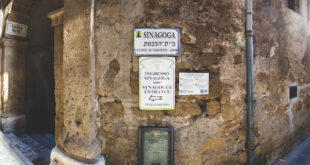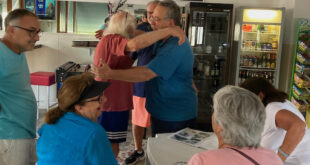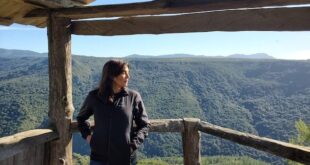
After six months of conspiring to surprise my father, Mario, in his birthplace of Sant’Andrea Apostolo dello Ionio, a medieval town overlooking the Ionian coast of Calabria, the final stage was set.
It was late June, before the summer crowds made their pilgrimage to enjoy the white beaches of the crystal-clear Gulf of Squillace along with the delicious fresh food and laidback lifestyle of southern Italy.
My daughters, Charlotte, 18, and Catie, 17, and I were en route to meet Dad and my co-conspirator and stepmother, Roberta, as well as Dad’s brother, Bruno, and Uncle Bruno’s wife, JoAnn.
This was an ideal time in the girls’ lives to soak in all the town had to offer, develop a better sense of their heritage and connect with their grandfather on a new level.
I had visited Sant’Andrea once before with Uncle Bruno as my guide in 2007, when I was 34. I wished I had the opportunity to come at an earlier age to unlock details of stories handed down by my grandparents, Carlo and Vittoria. I was proud to provide that chance for my daughters.
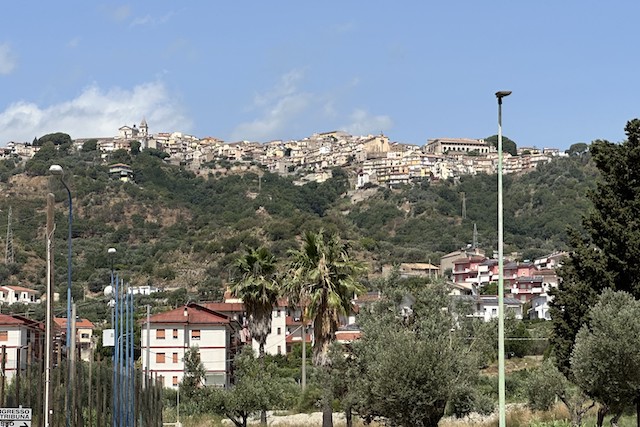
Our destination was Uncle Bruno’s house in Sant’Andrea Ionio Marina, one of the municipality’s two residential areas and a generally flat region nearest to the sea. The other area, Sant’Andrea Ionio Centro Storico, sits on three hills about 1,000 feet above sea level with the Serre mountains to its back. It was first developed in the 10th and 11th centuries near a grange founded by Basilian monks. Dad and his siblings were born in the vicinity.
To avoid arousing suspicion, Dad was told that a cousin was expected to stop by soon.
Aunt JoAnn met us outside and led the way.
“Well, I have bad news,” she announced to my father while walking through the blue-and-white-beaded door strands. “She’s not coming. She just texted me. But I have somebody else.”
With that, we entered.
As everyone laughed, hugged or cried happy tears, Dad sat motionless on the couch, looking at us and trying to process the situation. I had never seen him so stunned.
“I am still in shock,” he texted me hours later, adding at dinner another night, “I thought you were a mirage.”
Daily rhythms
A cappuccino and a cornetto at Pasticceria Sant’Andrea in the marina — which we indulged in every morning for the low, low price of 1 euro each — was a must during our stay. The cafe is where the paesans, many of them relatives, gathered no later than 9:30 a.m., when the Mediterranean sun’s heat started kicking into high gear.
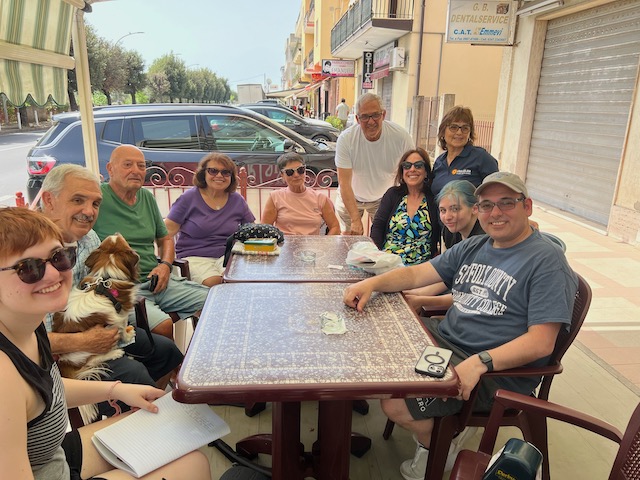
Charlotte, not normally a morning person, happily joined everyone for the alfresco chitchatting. “I like that I don’t feel rushed,” she said.
By 11 a.m., most people left for other plans, such as going to the beaches.
Most businesses in the area shut down from 1 to 4 p.m. for riposo, a daily ritual of rest that is a fitting part of the climate and culture. The area comes to life again at night, as restaurants open and people take passeggiate along the main strips and, of course, savor freshly made, creamy gelato.
We went out each night with Dad and Roberta, and sometimes with Uncle Bruno and my cousin Daniela and her husband, Franco.
Vibrant views
It takes about 50 turns to drive up from Sant’Andrea Marina to the outskirts of the historic center’s residential area. Catie counted as we ventured into the town.
We started at a small parking area about halfway up that offers expansive views of the coast, along with the area’s vast cover of citrus and olive trees.
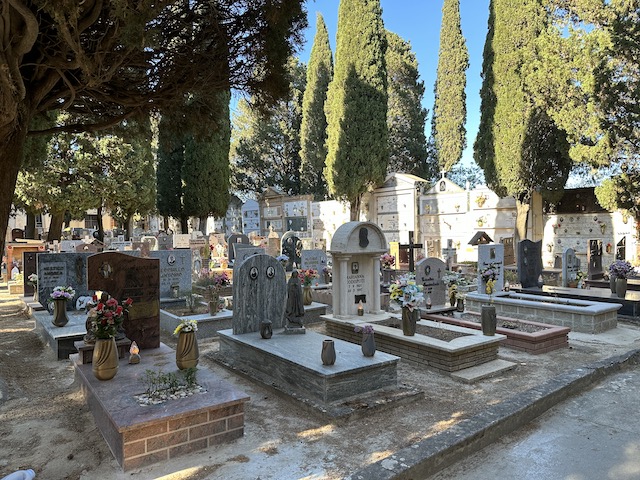
We made our way to the town’s meticulously kept three-tiered cemetery, which features in-ground plots surrounded by stone walls and numerous mausoleums. Profile photos are affixed to many sites, with names etched in, creating a sense of continued life.
We found cousins, aunts and great-grandparents. Their last names included Codispoti, Samà, Dominijanni and Coccari, the latter being my original surname, the one my grandfather bore. According to local author Salvatore Mongiardo, Coccari is historically specific to Sant’Andrea, deriving from the Greek island of Samos, which has a town called Kokkari.
‘Are you the Corry family?’
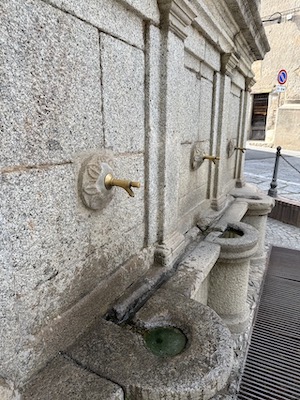
We made our way down to the town’s epicenter, Piazza Castello, or Castle Plaza, named after a castle that once stood nearby.
On one side of the piazza was a three-spout granite fountain. My grandmother Vittoria told me that, when she was a child, lines would form there to collect the day’s water for cooking and cleaning.
On our visit, the tre fontane were still in working order, and we washed our hands and faces. Catie was taken by the moment.
“It’s incredible,” she said, as the water flowed over her hand. “My great-grandmother was here, doing the same thing.”
Across from the fountains stood one of the town’s great elm trees, whose branches spread like protecting arms over the granite cobblestone street.
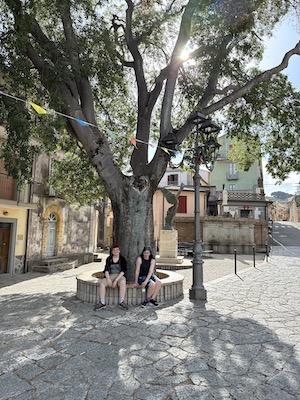
Walking down this tree-lined strip, Corso Umberto, we stopped at Bar Piancastello for gelato and espresso.
After a few minutes chatting with his friends in the local Andreolese dialect at the table next to us, a man called over, “Excuse me. Are you the Corry family?” I didn’t hear him, but Catie did, and she responded, “Yes!”
“Bruno or Mario?”
Now he had my attention.
“Mario.”
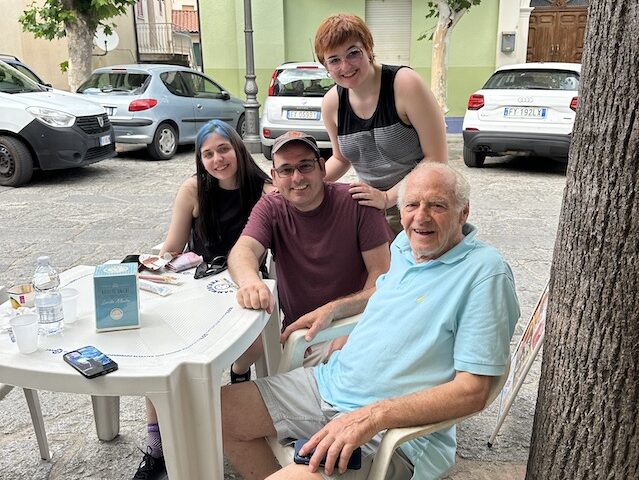
Domenico Papaleo said he recognized my face from Facebook and in his mind narrowed down the possible connections. He came over to join us. “I know all about your family.”
Domenico, 80, splits his time between Sant’Andrea and New Jersey, and is actually one of the rare direct descendants of our Coccari line.
He told us stories about my grandfather as a younger, free-spirited man.
“He was a jokester,” Domenico said. In the 1940s, my grandfather drove a three-wheeled cart called an “ape” to make money by delivering goods. “He used to put up a sign, ‘Ritorno Subito,’” and then would take his time returning, he laughed.
Domenico guided us all around town, past the centuries-old clock tower — the last standing tower of the old castle — through tiny back alleys intentionally designed to keep out incursions, to a section of town called Malajira, or “the wrong way.” It used to have a thriving square for vendors, including wine sellers. People were known to drink and get into fights there, hence the name, Domenico said.
We returned to Piazza Castello, where Domenico introduced us to everyone as Carlo Coccari’s grandchildren.
We suddenly became mini-celebrities. Everyone seemed to know my grandfather. When he moved to America, they explained, he often hosted paesans as they got their feet off the ground.
Charlotte and Catie at that moment developed a new sense of belonging.
Special moments
My late brother Christopher never visited Sant’Andrea, so Dad, Roberta, the girls and I spread some of his ashes in a lovely spot Charlotte picked near the cemetery that overlooks the whole town. He is forever connected.
Reflecting over dinner on our surprise visit and our adventures together, Dad said, “Now that they are here and are enjoying it, it really makes me happy to see smiles on their faces, to see the town, when they eat the food and they enjoy the people. It’s really a special moment.” Regarding Chris’ ceremony, he added, pausing with each word, “I was like, ‘Wow, I won’t forget that.’”
The above appears in the November 2024 issue of the print version of Fra Noi. Our gorgeous, monthly magazine contains a veritable feast of news and views, profiles and features, entertainment and culture. To subscribe, click here.
 Fra Noi Embrace Your Inner Italian
Fra Noi Embrace Your Inner Italian


